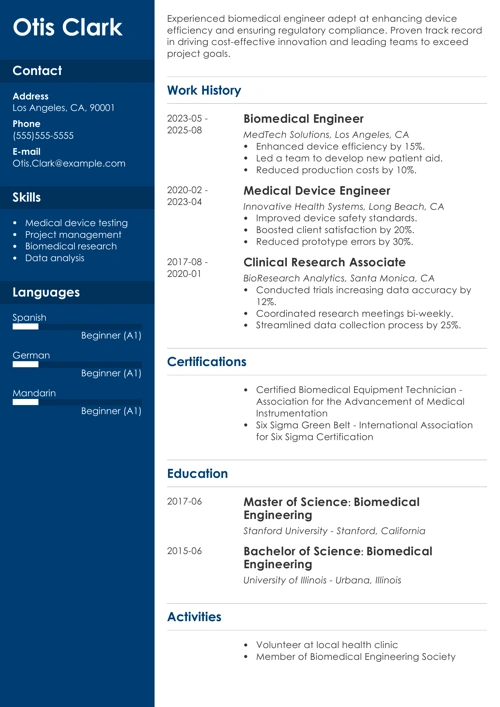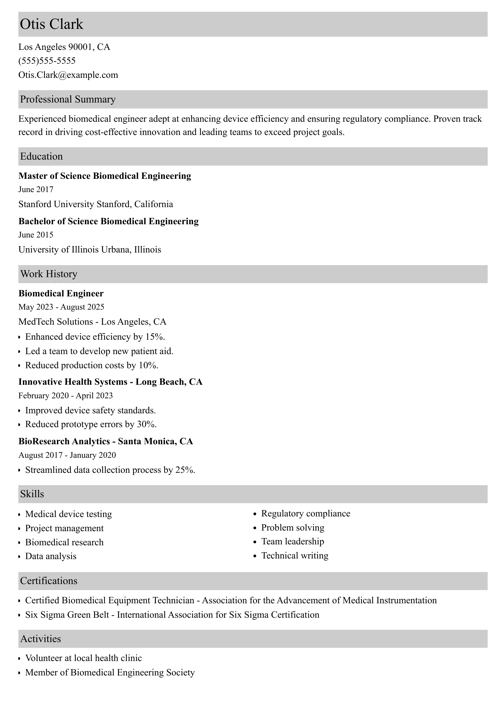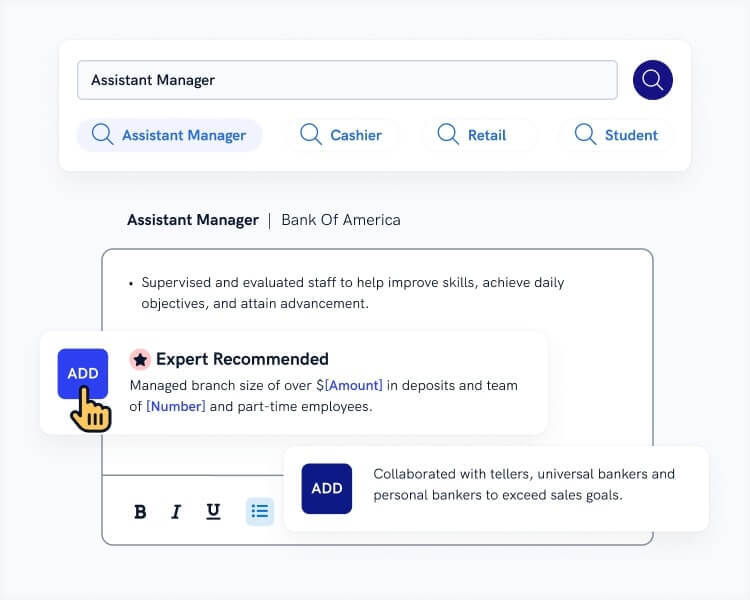As a biomedical engineer, you make sure the labs keep running smoothly. There are quality standards to meet and procedures to follow so that things operate the way they should.
The same applies to writing a good biomedical engineering resume. If you know how to execute it right, it will always deliver—and we happen to know the exact steps you should follow and the skills you should feature. We’ve also included a professional biomedical engineering resume example for your reference.
Want to save time and have your resume ready in 5 minutes? Try our resume builder. It’s fast and easy to use. Plus, you’ll get ready-made content to add with one click. Explore our free resume templates and start building your resume today.
Sample resume made with our builder—See more resume examples here.
Biomedical Engineering Resume Example
Otis Clark
Biomedical Engineer
520-721-0264
otis.clark@email.com
linkedin.com/in/otisclark
Summary
Biomedical engineer with 6+ years of experience specializing in equipment safety and compliance. Developed in-depth educational programs that proved efficient in raising technology awareness and long-term suitability of equipment usage. Proficient in planning and evaluating potential product viability. Eager to join the team at Neurogenesis to devise optimal operational protocols.
Work Experience
Biomedical Engineer
Triptia, Atlanta
June 2019–October 2022
Key Responsibilities:
- Researched and developed 5 new products with an ROI of 250%.
- Established specifications for equipment purchase and implementation: planning, budgeting, evaluation, and installation.
- Delivered on-site consulting to ensure that the equipment was utilized effectively and safely (up to 10 teams monthly).
Key Achievement:
- Carried out a major risk assessment and management study that led to an overhaul of the current practices and procedures and resulted in 3x improved equipment safety.
Biomedical Engineer
BioHealth, Atlanta
September 2016–May 2019
Key Responsibilities:
- Tested and calibrated a variety of medical equipment systems and resolved over 30 crucial malfunctions.
- Investigated incidents and safety alerts to ensure compliance with SMDA requirements.
- Conducted the decommissioning of medical equipment per established policies.
Key Achievement:
- Provided customized training to 150+ people, including third-party service vendors and student trainees.
Education
B.S. Biomedical Engineering
Georgia Institute of Technology, Atlanta
September 2012–July 2016
Skills
- Equipment maintenance
- Equipment safety
- Time management
- Teamwork
- Effective communication
- Self-motivated
Languages
- Chinese—Minimum working proficiency
How to Write a Biomedical Engineering Resume
These instructions will help you write a good biomedical engineering resume:
- Choose a suitable format for your resume:
- A reverse chronological resume is the one hiring managers usually expect to see, it focuses on your professional history.
- A functional resume, or skills-based resume, will revolve around your relevant skills (which can be good if you don’t have much field experience yet).
- A combination resume is a hybrid format that can do both.
- Decide on the resume sections. Mandatory ones include:
You can also utilize additional resume sections after these.
- Organize the structure:
- Map out the layout of your resume and left-align the contents.
- Keep it consistent with even resume margins on all sides, 1–1.5 line spacing, and a professional resume font (10–12 pts).
- Separate the document visually by adding section headings and using bold type/italics.
A good resume template can help you achieve a coherent look easier and will save time.
- Assemble the header. It should feature:
- Your name
- The position you’re applying for
- Contact information
- Summarize your career highlights:
- Write a brief paragraph describing your relevant experience and measurable successes.
- For an entry-level resume, pen a resume objective.
- Describe your work history:
- A targeted resume always works best, so align your statements with the job ad.
- Start each bullet with an action verb, include numbers and measurable accomplishments in your bullets, and add a key achievement.
- List your education:
- Include the final stage of your education; specify your degree, institution, and dates.
- For a recent college graduate resume, it’s possible to add a couple of bullet points describing your academic successes.
- Pick out skills. More on how to choose the skills for your biomedical engineer resume below.
- Use extra sections on your biomedical engineer resume for:
- Publications and content pieces
- Patents
- Research
- Continuing education/training, etc.
- Proofread your biomedical engineering resume:
- Check for lengthy sentences, reduce a few things for a more concise message.
- Opt for a two-column resume if you’d like to fit more onto a page, but don’t overload it with information.
- Save your resume as a PDF, and don’t forget to rename the file.
For more in-depth tips, read this article:How to Write a Resume (General Guide)
Pro Tip: To complete your application and make it more competitive, write a cover letter that develops on the ideas stated in your resume.
What Are the Top Biomedical Engineering Skills for a Resume?
Your job has a great deal to do with technical skills, so study the job description carefully and single out the specific hard skills the employer is looking for (particular types of software, experience with 3D printing, etc.). Keep in mind that you will most likely work closely with people, so good communication skills are crucial. A common denominator of many job postings is soft skills that have to do with planning and resource management, so do mention those.
Here are the top 10 biomedical engineering resume skills:
- Managing/maintaining clinical equipment
- Record keeping/reporting
- Knowledge of safety regulations
- CAD software
- Interpersonal skills
- Time management
- Strong organizational skills
- Attention to detail
- Problem-solving skills
- Critical thinking
Pro Tip: There’s no one-size-fits-all framework for an efficient biomedical engineering resume. You should always tailor your resume to every position you apply for.
Not what you’re looking for? See these guides:
Making a resume with our builder is incredibly simple. Follow our step-by-step guide, use ready-made content tailored to your job and have a resume ready in minutes.
When you’re done, Zety’s resume builder will score your resume and our ATS resume checker will tell you exactly how to make it better.
About Zety’s Editorial Process
This article has been reviewed by our editorial team to make sure it follows Zety's editorial guidelines. We’re committed to sharing our expertise and giving you trustworthy career advice tailored to your needs. High-quality content is what brings over 40 million readers to our site every year. But we don't stop there. Our team conducts original research to understand the job market better, and we pride ourselves on being quoted by top universities and prime media outlets from around the world.



